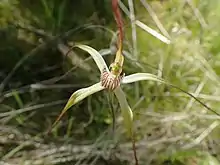| Caladenia exilis | |
|---|---|
 | |
| Scientific classification | |
| Kingdom: | Plantae |
| Clade: | Tracheophytes |
| Clade: | Angiosperms |
| Clade: | Monocots |
| Order: | Asparagales |
| Family: | Orchidaceae |
| Subfamily: | Orchidoideae |
| Tribe: | Diurideae |
| Genus: | Caladenia |
| Species: | C. exilis |
| Binomial name | |
| Caladenia exilis | |
| Synonyms[1] | |
| |
Caladenia exilis is a species of flowering plant in the orchid family Orchidaceae and is endemic to the south-west of Western Australia. It is a ground orchid with a single erect, linear leaf and up to three white to greenish-cream or dark pinkish-maroon flowers.
Description
Caladenia exilis is a terrestrial, perennial, deciduous, sympodial herb with a single, erect, linear leaf 40–100 mm (1.6–3.9 in) long and 4–7 mm (0.16–0.28 in) wide. The plant is 60–250 mm (2.4–9.8 in) high with up to three white to greenish-cream or dark pinkish maroon flowers, with two rows of red to cream-coloured calli along the mid-line of the labellum. The flowers are 60–150 mm (2.4–5.9 in) long and 40–60 mm (1.6–2.4 in) wide.[2][3][4]
Taxonomy and naming
Caladenia exilis was first formally described in 2001 by Stephen Hopper and Andrew Phillip Brown in the journal Nuytsia from specimens collected near Nyabing by Robert Bates in 1990.[5] The specific epithet (exilis) means "slender", "alluding to the slender labellum, petals and sepals".[4]
In the same journal Hopper and Andrew Brown described two subspecies of C. exilis, and the names are accepted by the Australian Plant Census:
- Caladenia exilis Hopper & A.P.Br. subsp. exilis[6] - salt lake spider orchid, has white to greenish-cream flowers with pale maroon markings.[2][3][4]
- Caladenia exilis subsp. vanleeuwenii M.A.Clem. & Hopper[7] - Moora spider orchid, has dark pinkish-maroon to cream-coloured or variegated flowers with prominent maroon markings.[2][3][4]
Distribution and habitat
Subspecies exilis grows near salt lakes between Mullewa and Woodanilling in the Avon Wheatbelt, Jarrah Forest and Mallee bioregions.[4][8] Subspecies vanleeuwenii grows in winter-wet depressions in salmon gum and york gum woodland, or on granite outcrops, north and south of Moora in the Avon Wheatbelt and Jarrah Forest bioregions of south-western Western Australia.[4][9]
References
- 1 2 "Caladenia exilis". Australian Plant Census. Retrieved 6 February 2023.
- 1 2 3 Brown, Andrew P.; Dixon, Kingsley W.; French, Christopher; Brockman, Garry (2013). Field guide to the orchids of Western Australia : the definitive guide to the native orchids of Western Australia. Floreat, W.A.: Simon Neville Publications. p. 60. ISBN 9780980348149.
- 1 2 3 Hoffman, Noel; Brown, Andrew (2011). Orchids of South-West Australia (3rd ed.). Gooseberry Hill: Noel Hoffman. pp. 35–36. ISBN 9780646562322.
- 1 2 3 4 5 6 Brown, Andrew P.; Hopper, Stephen (2001). "Contributions to Western Australian orchidology: 2. New taxa and circumscriptions in Caladenia". Nuytsia. 14 (1/2): 227–231. Retrieved 6 February 2023.
- ↑ "Caladenia exilis". APNI. Retrieved 7 February 2023.
- ↑ "Caladenia exilis subsp. exilis". Australian Plant Census. Retrieved 6 February 2023.
- ↑ "Caladenia exilis subsp. vanleeuwenii". Australian Plant Census. Retrieved 6 February 2023.
- ↑ "Caladenia exilis subsp. exilis". FloraBase. Western Australian Government Department of Biodiversity, Conservation and Attractions.
- ↑ "Caladenia exilis subsp. vanleeuwenii". FloraBase. Western Australian Government Department of Biodiversity, Conservation and Attractions.